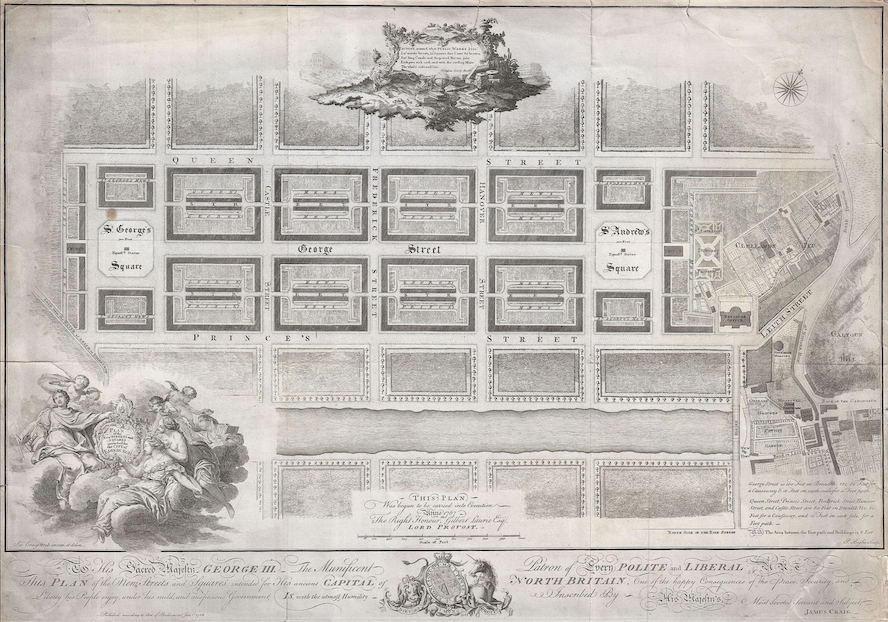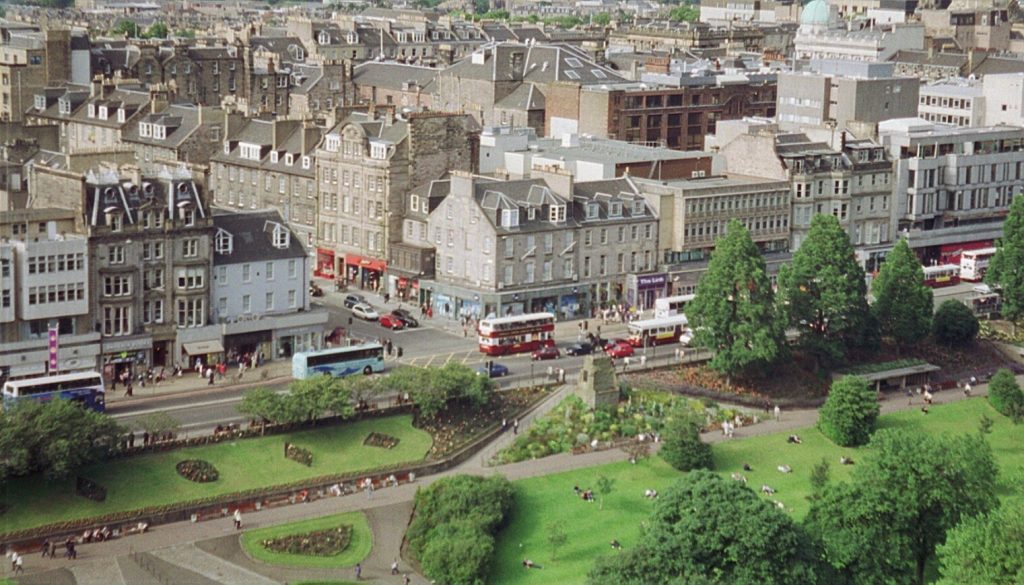OPENING UP MARKETS AND MINDS
Built in the mid-late 1770s as ‘a new environment encouraging human progress’, endowed with excellent communications and graced with an international classical architecture, Edinburgh’s New Town became the symbol of the ideals of the Scottish Enlightenment [1]. The movement’s figurehead, the philosopher and economist David Hume, settled and died there. In some of his essays he called for raising the quality of life with more foreign trade and better taste [2]. He even argued for the existence of standards of taste, based on critics’ excellence and impartiality whenever no rule had been formalised, as in the case of wine [3].
James Graig’s Plan for the New Town (1768) and Views from Edinburgh’s Castle (2002)
Science and rationality stood at the very core of this Age of Reason. Standardisation was seen as a good thing. Hume’s close friend Adam Smith laid the foundations of economics [4]. Their advocacy of free trade was based in good part on the evident benefits that Scotland had derived from its reluctant integration with England in 1707. Smith’s illustration of the absolute advantage enjoyed by Portugal over Scotland in the production of wine was an inspiration for the wine-for-cloth example in English-Portuguese trade that David Ricardo used later in his pivotal development of the notion of comparative advantage [5].
Hume’s, Smith’s and Ricardo’s free thoughts still reverberate today. Key to this opening up of minds and markets was an overtly optimistic embrace of change that freed people from ‘the weigh of senseless customs’ and cleared up rubbish gathered in many fields [6].
Today’s rational, scientific approach taken to everything of significance in the wine world, from grape bud to human brain, and the pace of global economic integration are working the same kind of wonders: stagnant or moribund markets such as Germany, the USA and Russia have been revived and new ones have emerged on the Pacific’s shores. Vineyards have been shifted by the winds of change blowing around the globe and international trade has grown by about half in volume over the last ten years alone [7]. Nowhere seems to have been spared the bright lights of this new Age of Reason – not even the offices of the EU administration (the EU Commission) that is now pushing for a more liberal wine policy [8].
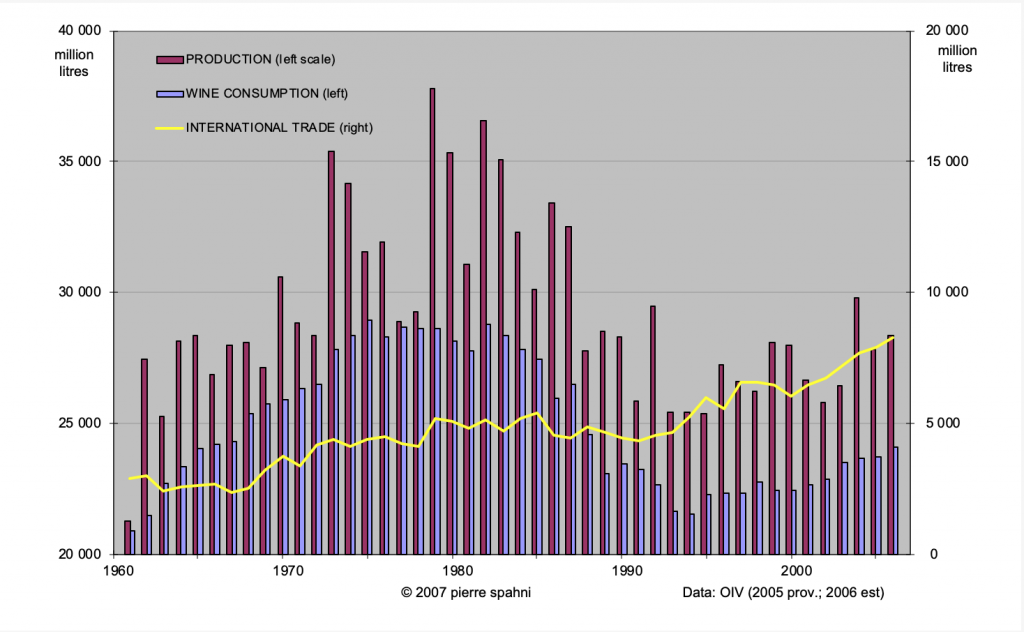
Figure 1: World wine production, consumption and trade
It was rising consumption in producing countries of the Old World (bolstered by European integration) plus the USA’s newly acquired taste for wine that had driven the previous expansion in international wine trade, from the mid-late 1960s to the mid-late 1970s. Imports were done mostly in bulk and usually for blending with domestic wines at that time. Nowadays trade is pulled in great part by rising demand in former beer strongholds in the Northern Hemisphere, i.e. the USA, China, the UK, Russia, Japan (now stagnating), the Netherlands, Canada, Belgium-Luxembourg, Denmark, Sweden and the Czech Republic – in that declining order of importance. Their combined increase is large enough to offset falling domestic wine consumption in the older, yet still important markets of France, Italy, Spain, Portugal and Argentina.
With the exception of Spain, West European producers have reduced or at least stabilised production over the past ten years, to bring supply back in line with shrinking domestic demand. This is in stark contrast to China, South Africa, Australia, Chile, Russia and Ukraine, who have all increased their output significantly. Most of the recent revival in world wine production has thus originated outside Europe, particularly in the New World and in China which is growing most of the wines it consumes.
Only now has trade become truly global. Economic growth and integration, together with the emergence of instantaneous communications, have helped world trade to shift from its Mediterranean cradle to the Pacific basin.
A bare forty years earlier, international trade still bore the mark of European colonialism. France, for one, used to import vast amounts of bulk from Algeria, mostly for blending. That flow alone accounted for well over a third of world trade in volume and about a quarter in terms of value (see Table 1). North African countries have been the main casualties of European integration, just as feared [9]; they have all disappeared from the world top exporters’ league. Italy swiftly replaced Algeria when a common market in wine was established in 1970 [10]. It was later displaced by Spain which joined the EU in the late 1980s and now supplies most of the cheap wines flowing into France.
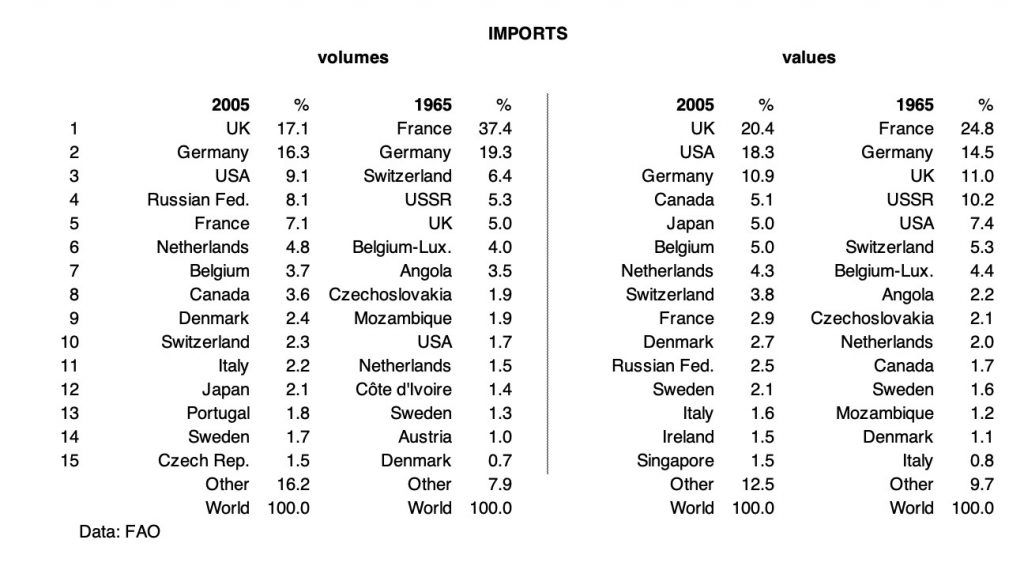
Table 1: Top 15 importers
The EU’s focus on shielding its bulk market against competition from outside, with what was effectively a minimum import price, left the bottled segment relatively unprotected. The Australians seized that window of opportunity to break into a flourishing UK market. The success they encountered in Britain earned them and other New World exporters staggering rates of growth (Chile, South Africa, the USA and to a lesser extent Argentina). Their rise contrasted with the demise of East European exporters, which were pushed down the league of world exporters by the implosion of the former Soviet Union and its satellite (COMECON) economies (see Table 2). Three of them – Hungary, Bulgaria and Romania – have since defected to the West and are now full members of the EU.
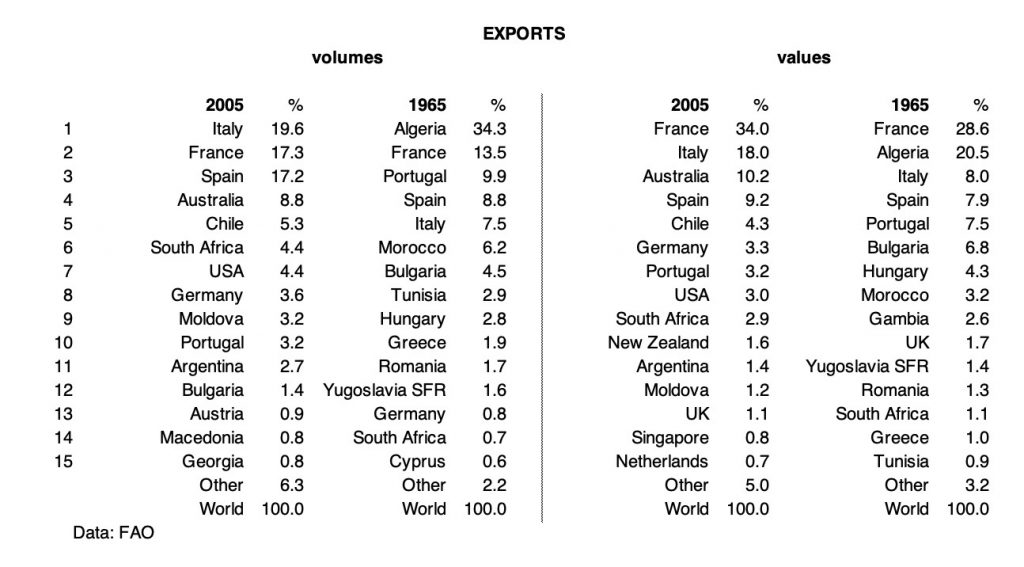
Table 2: Top 15 exporters.
International wine trade has grown three times in volume and at about twice that rate in real value terms over the last forty years on record, to reach just over US$ 20 billion in 2005. The pace has accelerated markedly ever since wine was included, with agriculture, in GATT’s endeavours to liberalise world trade – in the Uruguay Round of talks concluded in 1994, which gave birth to the WTO. From then on, most wine trade issues have been dealt with at the Geneva-based institution. In particular:
- Trade-distorting (domestic and export) subsidies, which are due to be phased out.
- Tariff levels and quotas: they are all subjected to scheduled reductions.
- Non-tariff barriers such as oenological practices and labelling requirements: they are now policed by rules on Sanitary and Phytosanitary and Technical Barriers to Trade.
- Intellectual Property Rights (trademarks and geographical indications): now part of the TRIPS Agreement.
A handful of (essentially New World) countries have also decided to venture further down the road to free trade and have organised themselves in a World Wine Trade Group whose members have accepted each other’s standards on oenological and labelling practices. The EU, which remains the biggest player, has opted for continuing bilateral negotiations with its key trade partners on the most pressing issues, e.g. it has finally renewed its Wine Accord (on oenological practices and the use of geographical indications) with the US and updated agreements with a few other countries too, e.g. South Africa and Australia.
But as witnessed with WTO negotiations, particularly those on Geographical Indications, change can be hopelessly slow, for not everyone is embracing it with equal ease. In the case of the EU particularly, one may now genuinely fear that Member States (the Council of Ministers) might force the Commission to amend its reform package beyond recognition – and probably effectiveness too.
The aim of the proposed policy change is, as ever, to clear the EU market of billions of litres of rubbish wines and to free its producers from the entanglement of past customs. It would give them more room to compete with the wines manufactured in the New World. But vested interests’ reluctance to change is neither new nor should it be underestimated: it has a long history (e.g. French Midi producers have just been celebrating a hundred years of organised resistance), opposition comes from many fronts (Italians and Spaniards have joined in the protest, as have Germans on a few issues) and it has been quite effective in the past: one only needs to look at past wine ‘reforms’ in 1976, 1982, 1988 and 1999 [11].
Seventeen years ago, I argued in a Food Policy article that the EU’s wine policy would fail in its attempt to resorb its production surplus for as long as it would not dare to move away from price support (distillation) [12]. ‘Tis evident (as David Hume would put it) that the EU has failed, since it is still admitting to nursing an excess production of one billion litres, at the yearly cost of half a billion Euros (for distillation alone) and lost market share all around the globe [13].
I had written that article in an idyllic attic flat in the heart of Edinburgh’s New Town – now a thriving financial centre and focal point for shopping, entertainment and art. I felt quite taken and humbled by the spirit of the Enlightenment. The book on The International Wine Trade was born there too, as was this companion website, launched into cyber space just seven years ago. Hope it continues to serve you well.
September 7th, 2007
NOTES
[1] Order, elegance, rationality, progress and proper social relationships. David Daiches The Scottish Enlightenment, The Saltire Society, Edinburgh, 1986.
[2] ‘Of the Delicacy of Taste and Passion’ (1741), ‘Of the Standard of Taste’ (1757), ‘Of Commerce’ (1752), ‘Of the Balance of Trade’ (1757), later compiled in Essays, Moral, Political and Literary (1758).
[3] See Ted Gracyk ‘Hume’s Aesthetics’ in Stanford Encyclopedia of Philosophy (on-line), 2003, also Barry C. Smith’s entry on ‘Philosophy and wine’ in The Oxford Companion to Wine (3rd ed.), Jancis Robinson (ed.), Oxford University Press, Oxford, 2006.
[4] An Inquiry into the Nature and Causes of the Wealth of Nations (1776).
[5] Adam Smith spoke of ‘natural or acquired advantage’ in the production of (agricultural and manufactured) goods in On The Principles of Political Economy and Taxation (1817). Robert Torrens made an early formulation of the principle of comparative advantage in a pamphlet entitled Essay on the External Corn Trade (1815); this is why one often refers to the Torrens-Ricardo principle of comparative advantage.
[6] Daiches (ibid.). See also Bryan Magee’s dialogue No 7 with John Passmore, on Hume, in The Great Philosophers – An Introduction to Western Philosophy, BBC Books, London, 1987. Albert Einstein, for instance, claimed that it was reading Hume that emboldened him to reject Newton’s theories.
[7] 54% and 47% between 1995 and 2005, for imports and exports respectively according to FAO, and by some 49% between 1996 (5.6 bn litres) and 2006 (estimated 8.3 bn litres) for exports according to OIV (see Figure 1).
[8] Proposal for a Council Regulation on the common organisation of the market in wine and amending certain Regulations COM(2007) 372, Commission of the European Communities, Brussels, July 2007.
[9] World Trade and Prospects for Ordinary Wine, Trade Intelligence Paper No 8, GATT, Geneva, 1966.
[10] Free trade within the EU’s internal market was only enforced after two ‘wine wars’ were waged by French Midi growers on ‘imports’ from Italy. Price support (through distillation) was increased in both countries in order to resolve the issue.
[11] See my books on The International Wine Trade (1995, 2000) and on The Common Wine Policy (1988) for details.
[12] ‘Wine budget stabilisers: a question of true balance’, Food Policy, April 1990:167-72. Because of the perverse effect that distillation has on wine quality and ultimately on prices. See note 5 of the ‘Off Balance‘ article of 18 May 2006.
[13] Fact Sheet – Towards a Sustainable European Wine Sector, The European Communities, Luxembourg, July 2007. One is talking about a structural surplus and not about yearly fluctuations in harvest size due to unusual weather conditions, such as this year’s heat waves and droughts that are causing a temporary reduction in world production.
© 2007 pierre spahni / www.span-e.com
You may quote or disseminate this article provided you make full reference to its author and website
